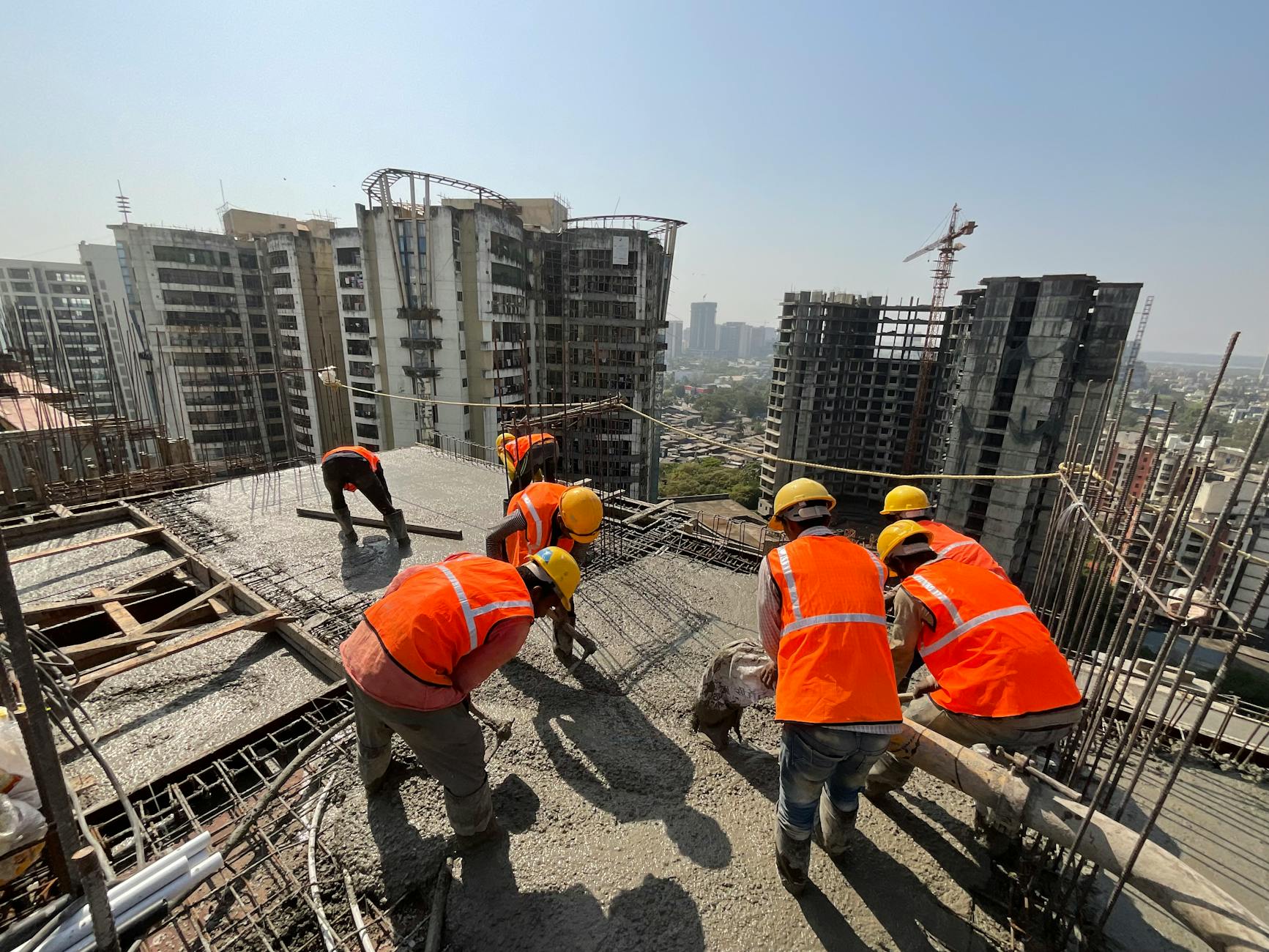
Concrete Pouring Hazards and Control Measures
Introduction
Concrete pouring is a critical process in construction that involves placing and setting concrete to form structural elements such as foundations, slabs, and columns. While essential, this task presents numerous hazards, including falls, chemical exposure, equipment-related risks, and structural failures. This guide outlines the key hazards associated with concrete pouring and the control measures to ensure a safe working environment.
Common Concrete Pouring Hazards and Their Control Measures
1. Falls from Heights
Hazard:
- Workers may fall from elevated structures such as formwork, scaffolding, or rebar frameworks.
- Slippery wet concrete surfaces increase the risk of slipping.
Control Measures:
- Install guardrails, toe boards, and safety nets around elevated work areas.
- Provide workers with fall protection equipment (harnesses, lanyards, and anchor points).
- Ensure safe access using ladders, scaffolding, or temporary platforms.
- Use non-slip footwear to prevent slips on wet concrete surfaces.
2. Structural Collapse or Formwork Failure
Hazard:
- Weak or improperly supported formwork can collapse under the weight of wet concrete.
- Overloading formwork beyond its design capacity leads to structural failures.
Control Measures:
- Use properly designed and braced formwork that can withstand concrete pressure.
- Follow engineering guidelines for load limits and curing time before removing formwork.
- Inspect formwork before and during concrete pouring for signs of instability.
- Control the rate of concrete pouring to prevent excessive lateral pressure.
3. Struck by Moving or Falling Objects
Hazard:
- Workers may be hit by tools, equipment, or materials falling from heights.
- Swinging or moving concrete pump booms can strike workers.
Control Measures:
- Establish exclusion zones around concrete pouring areas.
- Use tool lanyards and secured storage for equipment at heights.
- Train workers to maintain a safe distance from concrete pumping equipment.
- Wear personal protective equipment (PPE), including hard hats and high-visibility vests.
4. Exposure to Hazardous Chemicals
Hazard:
- Wet concrete contains alkaline compounds that can cause skin burns and eye injuries.
- Inhalation of cement dust can lead to respiratory problems.
Control Measures:
- Provide workers with appropriate PPE, including gloves, safety goggles, and respirators.
- Ensure workers wash exposed skin immediately after contact with concrete.
- Use proper ventilation or dust suppression methods to reduce airborne cement dust.
- Train workers on safe handling and emergency response for chemical exposure.
5. Manual Handling and Ergonomic Risks
Hazard:
- Lifting heavy concrete bags, tools, or reinforcing bars can cause musculoskeletal injuries.
- Poor posture and repetitive movements increase strain on the body.
Control Measures:
- Use mechanical lifting aids such as cranes, wheelbarrows, and concrete buggies.
- Train workers in proper lifting techniques and encourage team lifting for heavy loads.
- Rotate workers between tasks to minimize repetitive strain injuries.
- Organize workstations to reduce unnecessary bending, twisting, and reaching.
6. Electrical Hazards
Hazard:
- Concrete pumps, vibrators, and other electrical tools can pose a risk of electric shock.
- Contact with overhead power lines while operating equipment can cause electrocution.
Control Measures:
- Use only insulated and waterproof electrical tools in wet environments.
- Implement ground fault circuit interrupters (GFCIs) on all electrical circuits.
- Maintain a safe distance from overhead power lines and use spotters when operating tall equipment.
- Regularly inspect electrical tools and cords for damage before use.
7. Tripping and Slipping Hazards
Hazard:
- Wet concrete, spilled materials, and uneven surfaces increase the risk of slips and trips.
- Hoses, cables, and reinforcement bars on the ground create tripping hazards.
Control Measures:
- Keep work areas clean and organized to minimize obstacles.
- Use warning signs and barriers around wet concrete zones.
- Ensure workers wear slip-resistant footwear.
- Implement proper lighting in work areas to improve visibility.
8. Concrete Splash and Eye Injuries
Hazard:
- Concrete splashes can cause severe eye injuries and skin irritation.
- High-pressure concrete spraying increases the risk of splatter-related injuries.
Control Measures:
- Ensure workers wear safety goggles or face shields during concrete pouring.
- Provide full-body protection, including gloves, long-sleeved clothing, and waterproof boots.
- Train workers on safe handling techniques to minimize splashing risks.
- Have emergency eyewash stations readily available on-site.
9. Heat Stress and Fatigue
Hazard:
- Working under direct sunlight and high temperatures can cause heat exhaustion.
- Long hours of physically demanding work lead to fatigue and reduced concentration.
Control Measures:
- Provide adequate rest breaks and shaded areas for workers.
- Ensure workers stay hydrated and encourage the use of electrolyte-rich fluids.
- Schedule concrete pouring during cooler hours when possible.
- Monitor workers for signs of heat-related illnesses and take immediate action if symptoms appear.
10. Improper Use of Concrete Vibrators
Hazard:
- Excessive or incorrect use of concrete vibrators can lead to concrete segregation or collapse.
- Prolonged exposure to vibrating equipment can cause Hand-Arm Vibration Syndrome (HAVS).
Control Measures:
- Train workers on the proper technique and duration for using concrete vibrators.
- Limit exposure time to vibrating tools and provide anti-vibration gloves.
- Ensure vibrators are maintained in good working condition to minimize excessive vibration.
Conclusion
Concrete pouring is a high-risk activity that requires strict safety measures to protect workers from hazards such as falls, structural failures, chemical exposure, and equipment-related injuries. By implementing engineering controls, providing adequate personal protective equipment, and ensuring proper training, construction sites can minimize accidents and create a safer work environment.
Following these control measures not only enhances worker safety but also improves efficiency and quality in concrete pouring operations.
Common Hazards in Construction Sites and How to Mitigate Them
Batching Plant Hazards and Precautions | Free Download PPT
Monsoon Safety Plan for Construction Site
Safety Engineering in Construction: Managing Risks and Ensuring Compliance